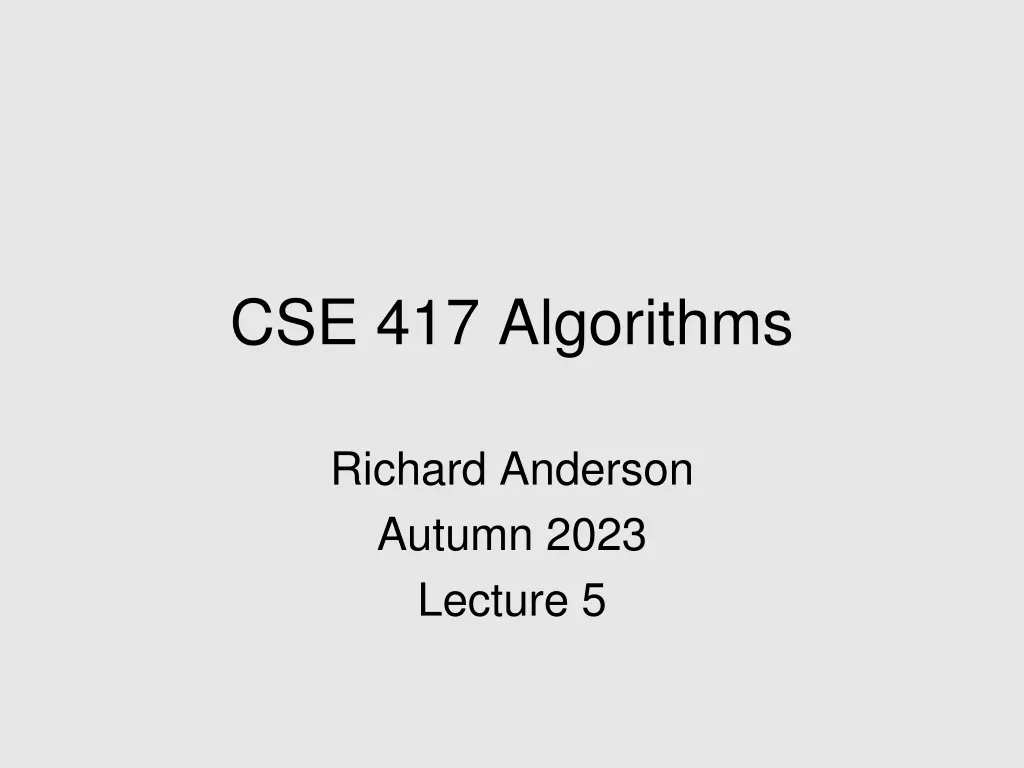
Algorithms and Graph Theory Concepts Overview
Explore fundamental concepts in algorithms, runtime functions, polynomial time, and graph theory. Learn about worst-case runtime, ignoring constant factors, formalizing growth rates, and efficient polynomial time algorithms. Delve into graph theory basics, including vertices, edges, paths, cycles, connectivity, and tree structures.
Download Presentation

Please find below an Image/Link to download the presentation.
The content on the website is provided AS IS for your information and personal use only. It may not be sold, licensed, or shared on other websites without obtaining consent from the author. If you encounter any issues during the download, it is possible that the publisher has removed the file from their server.
You are allowed to download the files provided on this website for personal or commercial use, subject to the condition that they are used lawfully. All files are the property of their respective owners.
The content on the website is provided AS IS for your information and personal use only. It may not be sold, licensed, or shared on other websites without obtaining consent from the author.
E N D
Presentation Transcript
CSE 417 Algorithms Richard Anderson Autumn 2023 Lecture 5
Announcements HW 1 Due tonight on Gradescope, turn in open until Sunday, 11:59 pm HW 2 Available Includes problems from LeetCode
Worst Case Runtime Function Problem P: Given instance I compute a solution S A is an algorithm to solve P T(I) is the number of steps executed by A on instance I T(n) is the maximum of T(I) for all instances of size n
Ignore constant factors Constant factors are arbitrary Depend on the implementation Depend on the details of the model Determining the constant factors is tedious and provides little insight Express run time as T(n) = O(f(n))
Formalizing growth rates T(n) is O(f(n)) [T : Z+ R+] If n is sufficiently large, T(n) is bounded by a constant multiple of f(n) Exist c, n0, such that for n > n0, T(n) < c f(n) T(n) is (f(n)) T(n) is at least a constant multiple of f(n) There exists an n0, and > 0 such that T(n) > f(n) for all n > n0 T(n) is (f(n)) if T(n) is O(f(n)) and T(n) is (f(n))
Efficient Algorithms Polynomial Time (P): Class of all problems that can be solved with algorithms that have polynomial runtime functions Polynomial Time has been a very successful tool for theoretical computer science Problems in Polynomial Time often have practical solutions
Graph Theory G = (V, E) V vertices E edges Undirected graphs Edges sets of two vertices {u, v} Directed graphs Edges ordered pairs (u, v) Many other flavors Edge / vertices weights Parallel edges Self loops
Definitions Path: v1, v2, , vk, with (vi, vi+1) in E Simple Path Cycle Simple Cycle Neighborhood N(v) Distance Connectivity Undirected Directed (strong connectivity) Trees Rooted Unrooted
Graph Representation V = { a, b, c, d} b a E = { {a, b}, {a, c}, {a, d}, {b, d} } d c b c d a 1 1 1 a d b 1 0 1 1 0 0 c a 1 1 0 d a b Adjacency List Incidence Matrix
Implementation Issues Graph with n vertices, m edges Operations Lookup edge Add edge Enumeration edges Initialize graph Space requirements
Graph search Find a path from s to t S = {s} while S is not empty u = Select(S) visit u foreach v in N(u) if v is unvisited Add(S, v) Pred[v] = u if (v = t) then path found
Breadth first search Explore vertices in layers s in layer 1 Neighbors of s in layer 2 Neighbors of layer 2 in layer 3 . . . s
Key observation All edges go between vertices on the same layer or adjacent layers 1 2 3 4 5 6 7 8
Bipartite Graphs A graph V is bipartite if V can be partitioned into V1, V2 such that all edges go between V1 and V2 A graph is bipartite if it can be two colored
Algorithm Run BFS Color odd layers red, even layers blue If no edges between the same layer, the graph is bipartite If edge between two vertices of the same layer, then there is an odd cycle, and the graph is not bipartite
Theorem: A graph is bipartite if and only if it has no odd cycles
Lemma 1 If a graph contains an odd cycle, it is not bipartite
Lemma 2 If a BFS tree has an intra-level edge, then the graph has an odd length cycle Intra-level edge: both end points are in the same level
